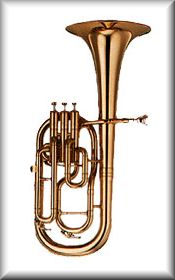
The word horn is often used as a generic term for any brass instrument. In brass band instrumentation the horn section consists of upright saxhorns pitched in E𝄬, called tenor horns or alto horns. The most common figuration is the straight upright, with the bell pointing upward. Marching versions with the bell facing front are sometimes seen. Almost all tenor horns are constructed with three valves. Many newer designs have triggers, or levers, which move the tuning slides to help compensate for the intonation issues inherent to all brass instruments.
Role in the Brass Band
The E𝄬 tenor horn is considered one of the “mellow” instruments in the brass band. In four-part arrangements, the horns are used for the alto and tenor voices. Because the range of the horn is between that of the bright-sounding cornets and trombones, the darker sound is sometimes difficult to hear. However, the horn sound is a key component of the overall sound of a brass band, anchoring the “middle” of the band. The horn is also used as a solo instrument, though not as frequently as the cornet or euphonium.
Tenor Horn vs. French Horn
The orchestral French horn is built in a circular pattern, and is played with the bell facing down and toward the rear. The modern French horn is usually a double horn, pitched in F and B𝄬, with three rotary valves and a fourth valve that switches between the F and B𝄬 halves of the horn. Unlike most brass instruments, the valves are operated with the left hand. The right hand is positioned in the flare of the bell and is used to partially control the sound and pitch of the instrument.
A French horn mouthpiece is smaller in diameter than that of the tenor horn and has a deep, funnel-shaped cup. The flare of the bell is very wide. The tubing of a French horn is considerably longer than that of the tenor horn (the fundamental note of a F horn is the same as that of an F tuba). Because of the small mouthpiece and narrow bore of the French horn, the player is always playing in the upper partials of the notes. This makes the sound very intense, but sometimes difficult to control. Special effects, such as the fast lip arpeggio, commonly referred to as a “rip”, are possible because the overtones are close together in the upper range.
The use of the tenor horn instead of the French horn is rooted in tradition. Many brass bands play on the march, and a French horn is difficult to play while marching. The tone quality of the tenor horn is also a better blend with the other instruments of the brass band, some of which are also from the saxhorn family.
